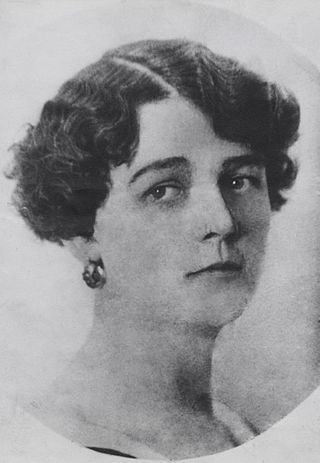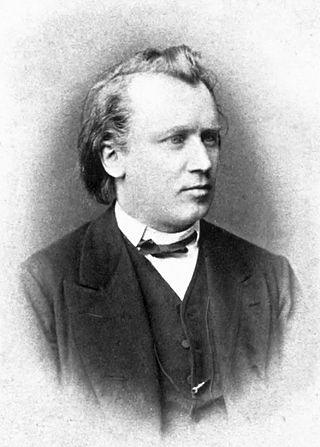Related Research Articles

Varvara Jmoudsky, better known as Barbara Karinska or simply Karinska, was the Oscar-winning costumier of cinema, ballet, musical and dramatic theatre, lyric opera and ice spectacles. Over her 50-year career, that began at age 41, Karinska earned legendary status time and again through her continuing collaborations with stage designers including Christian Bérard, André Derain, Irene Sharaff, Raoul Pêne du Bois and Cecil Beaton; performer-producers Louis Jouvet and Sonja Henie; ballet producers René Blum, Colonel de Basil and Serge Denham. Her longest and most renown collaboration was with choreographer George Balanchine for more than seventy ballets — the first known to be “The Celebrated Popoff Porcelain,” a one act ballet for Nikita Balieff's 1929 La Chauve-Souris with music by Tchaikovsky for which Karinska executed the costumes design by Sergey Tchekhonin. She began to design costumes for Balanchine ballets in 1949 with Emmanuel Chabrier's “Bourrèe Fantasque,” for the newly founded New York City Ballet. Their final collaboration was the 1977 "Vienna Waltzes.” Balanchine and Karinska together developed the American tutu ballet costume[9] which became an international costume standard.

Stars and Stripes is a neoclassical ballet choreographed by George Balanchine to music by John Philip Sousa, orchestrated by Hershy Kay. The ballet was made as a tribute to the United States, Balanchine's adopted country. It premiered on January 17, 1958, at the City Center of Music and Drama, danced by the New York City Ballet. It is dedicated to Fiorello La Guardia, former mayor of New York City. The ballet had been revived by multiple ballet companies, and at different special occasions.
Symphony in C, originally titled Le Palais de Cristal, is a ballet choreographed by George Balanchine, to Georges Bizet's Symphony in C. The ballet was originally created for the Paris Opera Ballet, and premiered on July 28, 1947 at Théâtre National de l'Opéra.
Kyra Nichols is an American retired ballet dancer and teacher. She joined the New York City Ballet in 1974 and was promoted to principal dancer in 1979. She is one of the last dancers to have worked with George Balanchine, although he did not create any new work on her. However, she originated roles in several ballets by Jerome Robbins. Nichols retired from performing in 2007, after a 33-year career.
Bugaku is a ballet made by New York City Ballet co-founder and ballet master George Balanchine to eponymous music by Toshiro Mayuzumi, commissioned by City Ballet in 1962. The premiere took place on 30 March 1963 at City Center of Music and Drama, New York, with scenery by David Hays, costumes by Karinska, and lighting by Ronald Bates. NYCB had toured Japan in 1958 and the Gagaku Company of the Imperial Household toured the US the following year.
La Sonnambula(The Sleepwalker) is a ballet by the co-founder and ballet master of New York City Ballet, George Balanchine, made to Vittorio Rieti's music using themes from the operas of Vincenzo Bellini including La Sonnambula, Norma, I Puritani and I Capuleti e i Montecchi (1830–35).

Dances at a Gathering is a ballet choreographed by Jerome Robbins to music by Frédéric Chopin, with costumes designed by Joe Eula. The ballet premiered on May 22, 1969, at the New York State Theater, performed by the New York City Ballet.
Brahms–Schoenberg Quartet is a one-act ballet by George Balanchine, to Johannes Brahms's Piano Quartet No. 1, orchestrated by Arnold Schoenberg. The ballet premiered on April 21, 1966 at the New York State Theater, performed by the New York City Ballet.
Chaconne is a ballet made by New York City Ballet co-founder and ballet master George Balanchine to ballet music from Gluck's Orfeo ed Euridice. The premiere took place Wednesday, 22 January 1976 at the New York State Theater, Lincoln Center, with lighting by Ronald Bates; Robert Irving conducted. Chaconne was danced in practice clothes at its premiere; Karinska's costumes were added in the spring season.
Vienna Waltzes is a ballet choreographed by George Balanchine to music by Johann Strauss II, Franz Lehár and Richard Strauss, made as a tribute to Austria. It premiered on June 23, 1977 at the New York State Theater, performed by the New York City Ballet, and was an immediate success among the public.

Who Cares? is a ballet choreographed by George Balanchine to songs by George Gershwin that were orchestrated by Hershy Kay. The ballet is split in two parts, the first danced by an ensemble, and the second focuses on four principal dancers. Who Cares? premiered on February 5, 1970, at the New York State Theater, danced by the New York City Ballet.
Scherzo à la Russe is a ballet choreographed by George Balanchine to Stravinsky's music of the same name. The ballet was created for New York City Ballet's Stravinsky Festival, a tribute to the composer after his death, and premiered on June 21, 1972, at the New York State Theater, with the two lead roles originated by Karin von Aroldingen and Kay Mazzo.

Allegro Brillante is a ballet choreographed by George Balanchine to Tchaikovsky's Piano Concerto No. 3. The ballet is danced by a principal couple and a corps de ballet of eight. Balanchine said it "contains everything I knew about classical ballet." Allegro Brillante was made for the New York City Ballet, and premiered on March 1, 1956, at the City Center of Music and Drama, with Maria Tallchief and Nicholas Magallanes originating the two principal roles.
Liebeslieder may refer to love songs in general, or to these specific works:

Johannes Brahms' Liebeslieder Waltzes (Liebeslieder-Walzer) are distributed across two opus numbers: Op. 52 and Op. 65. The waltzes are a collection of love songs in Ländler style for voices and piano four hands. The lyrics for the Liebeslieder come from Georg Friedrich Daumer's Polydora, a collection of folk songs and love poems. While there is no concrete record indicating the exact inspiration for the Waltzes, there is speculation that Brahms' motivation for the songs was his frustrated love for pianist and composer Clara Schumann.
Stephanie Saland is an American former ballet dancer and teacher. She was spotted by George Balanchine whilst a student at the School of American Ballet, then joined the New York City Ballet in 1972, and was promoted to principal dancer in 1984. She had created roles for both Balanchine and Jerome Robbins, before retiring in 1993. She then started teaching ballet in both the U.S. and internationally.

Unity Sickles Phelan is an American ballet dancer. She joined the New York City Ballet in 2013 and was promoted to principal dancer in 2021. Outside of the company, she had also danced in the films John Wick: Chapter 3 – Parabellum (2019) and I'm Thinking of Ending Things (2020).
Maria Calegari is an American ballet dancer, teacher and répétiteur. She joined the New York City Ballet in 1974 and became a principal dancer in 1983. She left the company in 1994, then occasionally performed until 2004. She also teaches ballet and began working as a répétiteur for the Balanchine Trust and Robbins Rights Trust in 1996 and 2003 respectively.
Kammermusik No. 2 is a ballet choreographed by George Balanchine to Paul Hindemith's music of the same name. The ballet premiered on January 26, 1978, at the New York State Theater, danced by the New York City Ballet.
Divertimento No. 15 is a ballet choreographed by George Balanchine to Mozart's eponymous music. The ballet was made for the New York City Ballet. Balanchine first choreographed the score in 1952, for a ballet titled Caracole. In 1956, he planned to revive Caracole for a celebration of Mozart's bicentenary but made a new ballet to the same music instead. Divertimento No. 15 premiered on May 31, 1956, at the American Shakespeare Theatre, Stratford, Connecticut.
References
- 1 2 3 4 5 6 7 "Liebeslieder Walzer". Oxford Reference.
- 1 2 "Liebeslieder Walzer". New York City Ballet.
- 1 2 Kisselgoff, Anna (20 May 1984). "Dance View; Balanchine Infused Waltzes With Subtle Drama". The New York Times.
- 1 2 Macaulay, Alastair (2 October 2015). "Review: 'Liebeslieder Walzer' and 'Tschaikovsky Suite No. 3,' Balanchine Couples Baring Their Souls". The New York Times.
- 1 2 3 4 5 Macaulay, Alastair (26 February 2019). "Balanchine's Dark Waltzes: Can Love Suffice?". The New York Times.
- ↑ Macaulay, Alastair (21 May 2012). "Expressions of Love That Bridge Real and Ethereal Worlds". The New York Times.
- 1 2 3 4 Kisselgoff, Anna (12 May 1984). "Dance: 'Liebeslieder; Restored By City Ballet". The New York Times.
- ↑ Anderson, Jack (15 January 1999). "Dance Review; The Wonders of Waltzing, In Fantasy And Reality". The New York Times.
- ↑ Dunning, Jennifer (3 May 2004). "Dance Review; Present Congratulates Past, Bowing to City Ballet Alumni". The New York Times.
- 1 2 3 4 5 Martin, John (23 November 1960). "Ballet: Brahms' Waltzes". The New York Times.
- 1 2 Jennings, Luke; Bull, Deborah (2004). The Faber Pocket Guide to Ballet. ISBN 9780571260959.
- 1 2 Sulcas, Roslyn (19 May 2006). "All Balanchine and All Brahms at the New York City Ballet". The New York Times.
- 1 2 Taper, Bernard (5 January 1997). "Keepers of the Treasured Balanchine Flame". The New York Times.
- ↑ Kaufman, Sarah (20 October 2008). "A Leap to Lift Spirits". The Washington Post.
- ↑ Kisselgoff, Alastair (22 February 2000). "Ballet Review; An Evening of Spats, Whispers and Passion in the Drawing Room". The New York Times.
- ↑ Reynolds, Nancy (1977). Repertory in Review.
- 1 2 3 "335. Liebeslieder Walzer". The George Balanchine Foundation.
- ↑ "New York City Ballet Announces Casting for Weeks One and Two of Their Digital Season". BroadwayWorld. 21 September 2020.